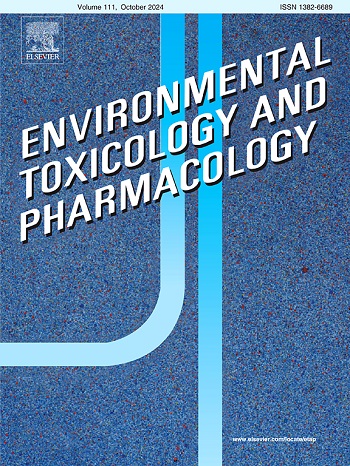Toxic effects of microplastics (polyethylene) exposure on acetylcholinesterase, stress indicators and immunity in Korean Bullhead, Pseudobagrus fulvidraco
IF 4.2
3区 环境科学与生态学
Q2 ENVIRONMENTAL SCIENCES
引用次数: 0
Abstract
Microplastics (MPs) in aquatic environments can have toxic effects on various organisms, including fish. This study exposed Pseudobagrus fulvidraco to polyethylene MPs at 0, 10 mg/L (approximately 9.50 ×108 particles/L), 20 mg/L (approximately 1.9 ×109 particles/L), 5000 mg/L (approximately 4.75 ×1011 particles/L), and 10,000 mg/L (approximately 9.50 ×1011 particles/L) concentrations for 96 h. At relatively lower MPs concentrations (0, 10 and 20 mg/L), no significant changes were observed in acetylcholinesterase (AChE) activity, stress indicators (heat shock protein 70 and cortisol), or immune responses (lysozyme activity and immunoglobulin M levels). However, at higher MPs concentrations (5000 and 10,000 mg/L), AChE activity was significantly inhibited, stress indicators were significantly increased, and immune responses were significantly decreased. Our results indicate that acute exposure of P. fulvidraco to MPs had negligible effects at concentrations below 20 mg/L, whereas significant toxic effects such as AChE activity inhibition, stress responses, and immune suppression were observed at concentrations above 5000 mg/L. Therefore, our study highlights the risks of severe MPs pollution on aquatic ecosystems and fish health.
求助全文
约1分钟内获得全文
求助全文
来源期刊
CiteScore
7.00
自引率
4.70%
发文量
185
审稿时长
34 days
期刊介绍:
Environmental Toxicology and Pharmacology publishes the results of studies concerning toxic and pharmacological effects of (human and veterinary) drugs and of environmental contaminants in animals and man.
Areas of special interest are: molecular mechanisms of toxicity, biotransformation and toxicokinetics (including toxicokinetic modelling), molecular, biochemical and physiological mechanisms explaining differences in sensitivity between species and individuals, the characterisation of pathophysiological models and mechanisms involved in the development of effects and the identification of biological markers that can be used to study exposure and effects in man and animals.
In addition to full length papers, short communications, full-length reviews and mini-reviews, Environmental Toxicology and Pharmacology will publish in depth assessments of special problem areas. The latter publications may exceed the length of a full length paper three to fourfold. A basic requirement is that the assessments are made under the auspices of international groups of leading experts in the fields concerned. The information examined may either consist of data that were already published, or of new data that were obtained within the framework of collaborative research programmes. Provision is also made for the acceptance of minireviews on (classes of) compounds, toxicities or mechanisms, debating recent advances in rapidly developing fields that fall within the scope of the journal.

 求助内容:
求助内容: 应助结果提醒方式:
应助结果提醒方式:


